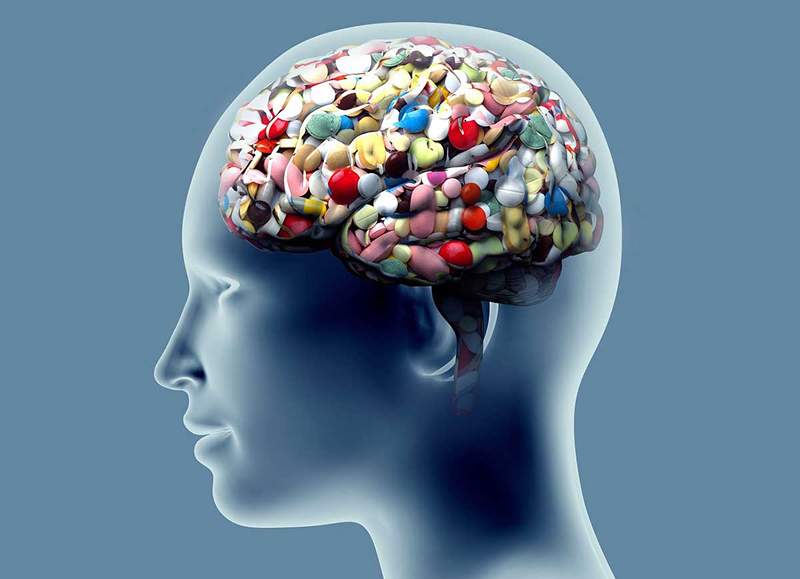What are psychopharmaceuticals and how they act?

- 2274
- 733
- Lorenzo West I
Psychopharmaceuticals are used in the treatment of mental illnesses. The causes of mental illnesses are still unknown, but in some cases it has been possible to verify the existence of cerebral metabolic alterations; The best known are those related to brain neurotransmitters.
Content
Toggle- How psychopharmaceuticals act
- Neuroleptics or antipsychotics
- Anxiolytics and sedatives
- Antidepressants
- Antirrecential or stabilizers of mood
- References
How psychopharmaceuticals act
Neurotransmitters are substances that are released in neuronal synapses and that when acting on specific receptors intervene in the transmission of nerve impulses. The most important are acetylcholine, norepineuse, dopamine, 5-hydroxytryptamine (serotonin) and gamma-aminobutiric acid (GABA).
In the states of hyperactivity and agitation there are usually high concentrations of neurotransmitters in synapses, while in depressive states its concentration is usually diminished.
Most psychopharmaceuticals act by modifying the effects of brain neurotransmitters.
Some reduce the concentration of neurotransmitters in the synapse or prevent their effect by blocking the receptors on which they act, this usually produces an improvement of the psychotic states, especially if accompanied by agitation. Other psychopharmaceutical. However, many aspects of mental illnesses cannot be explained solely by the alterations of neurotransmitters, so some psychopharmaceuticals seem to have other mechanisms of action.
Some psychopharmaceuticals act in the cerebral cortex, but mostly do so on deeper encephalic structures, such as the ascending reticular system of the brain trunk or the limbic system, in which complex brain functions, such as emotions, memories and affectivity.
Psychopharmacology has substantially modified the prognosis of mental illnesses. At present, almost all psychiatric patients improve with pharmacological treatment and most can be treated.
Frequently psychopharmaceuticals only manage to control the great symptoms or syndromes of mental disorders, such as agitation, anxiety or depression, but in some cases, they seem to achieve the healing of the disease.
Psychopharmaceuticals are usually classified into four large groups:
1. Neuroleptics or antipsychotics
2. Anxiolytics and sedatives
3. Antidepressants
4. Antirrecential or stabilizers of mood
Neuroleptics or antipsychotics
Neuroleptics or antipsychotics They are mainly used in the treatment of psychosis, such as schizophrenia, The maniac phase of manic-depressive psychosis (bipolar psychosis) and toxic psychosis. They are also used in the symptomatic treatment of acute agitation and delirium states, in confusional states and in some cases of chronic pain.
Neuroleptics were formerly called older soators, a term that is abandoned because they are not only tranquilizers, but seem to improve the cause of psychosis; Agitation is certainly a frequent component of psychosis, but antipsychotics are also administered to patients who are not agitated.
In principle all neuroleptics are effective and the choice of one or the other depends on the previous response of the patient to the drug and the adverse effects that arise. Some are prolonged, and in principle they are more effective in chronic situations.
 Lorazepam: A type of benzodiazepine
Lorazepam: A type of benzodiazepine Anxiolytics and sedatives
Anxiety can be defined as a feeling of fear, fear, apprehension and uncertainty without just cause. When accompanied by vegetative symptoms such as sweat, tremor, tachycardia, etc. Receive the anguish.
Ansiolithics are psychopharmaceuticals capable of controlling anxiety. At present, the most used are benzodiazepines and buspirone. The first group has an anxiolytic, hypnotic-sedating effect (which helps to treat insomnia), muscle and anticonvulsive relaxant. Buspirona in a pure anxiolytic, with hardly hypnotic or tranquilizer effects. However, its effects take 2 to 3 weeks to appear and in general it is less effective than benzodiazepines.
Antidepressants
Depression is a disease characterized by feelings of sadness, pessimism, lack of interest, psychomotor delay, insomnia, eating disorders and others. There is often an associated component of anxiety or anguish, feelings of guilt, panic crisis and suicide tendency.
The antidepressant drugs are used in the treatment of all forms of depression, although in general they respond better to endogenous depressions. About 80% of all depressions respond to pharmacological treatment. This must be maintained for 4-6 months and gradually suspended, since if it is suspended before or abruptly, relapses are frequent.
In Depressive states are usually a low concentration of neurotransmitters In neuronal synapses, especially norepinephrine and serotonin. Antidepressant drugs tend to raise the concentration of neurotransmitters in synapses. This can be achieved by two mechanisms: blocking or delaying the reuptake of neurotransmitters, which increases their concentration in synapses, or inhibiting monoaminexidase (MAO), which in normal circumstances destroys aminic neurotransmitters, limiting their time of action. The inhibition of the MAO manages to extend the action time of the neurotransmitters.
Most antidepressants act by one of these two mechanisms, although some also increase the number or sensitivity of synaptic receptors for neurotransmitters.
Antirrecential or stabilizers of mood
A mood stabilizer is a psychiatric medicine used for Treatment of mood disorders, characterized by intense and maintained changes in mood. The most common is bipolar disorder, in which mood stabilizers suppress the oscillations between manic and depressive episodes.
These drugs are also used to treat personality limit disorder.
The majority of mood stabilizers are also anticonvulsive, with the exception of lithium, which is the oldest and most known mood stabilizer drug. They are drugs that decrease the frequency and/or intensity of the different episodes of bipolar disorder, without increasing the frequency and intensity of any of the other types of episodes.
Visit our Psychopharmaceutical section with medications organized by types of mental illness.
Psychopharmaceutical medications
References
- Stahl, s.M. (1998) Essential psychopharmacology. Neuroscientific bases and clinical applications. Barcelona: Ariel.

